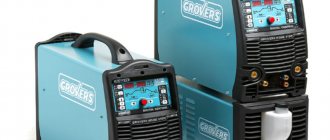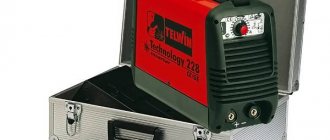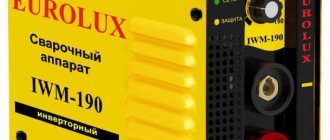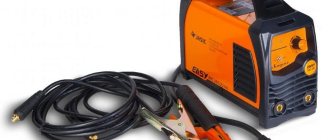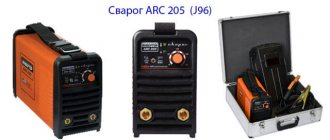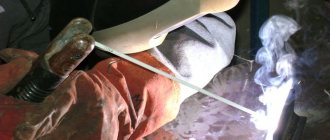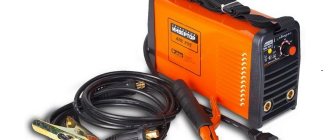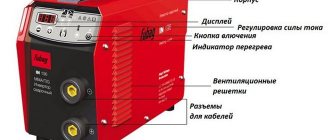- Types and methods of metal welding
- Welding arc
- How to cook using electric arc welding
- Arc welding lessons
- Metal welding modes
- Main settings
How to weld metal and what is welding? This is a permanent connection of metal parts, which is formed as a result of their heating at the joining point to a molten state. The melted and then solidified material is called a weld. Not all metals can be welded. Homogeneous materials are excellently welded. For example, cast iron with cast iron or copper with copper (moreover, manual arc welding of copper is performed in shielding gas). Iron and chromium, nickel and copper are well cooked. This happens because these metals form well-mixed layers in the liquid state.
Pipe welding
But if you try to weld copper with lead, then nothing will come of this idea - these metals do not mix with each other. The same can be said about iron and magnesium or aluminum and bismuth. If it is necessary to weld such pairs, metals are added to the mixture that can dissolve with each component of the pair. In other words, in our time there are no secrets on how to weld metals.
Choosing an inverter for home and part-time work
For the last twenty years, inverters have occupied the podium of welding equipment for home craftsmen. Unlike bulky transformer “welders”, inverters can be freely carried on the shoulder and transported anywhere on a construction site. Some models allow you to repair a car by spot welding, others have an argon-arc function for connecting two parts without an electrode wire. There are also semi-automatic machines for serious installation work. Which inverter should I buy? Let's look at the selection criteria "at a glance".
Selecting the manual arc welding mode
The stability of the welding process and the quality of welding depend on the correctly selected modes. There are basic and additional parameters.
Main parameters:
- Properties of welding current (magnitude, polarity and type);
- Electrode diameter;
- Arc voltage;
- Speed of the welding process;
- The magnitude of transverse vibrations of the electrode end.
Extra options:
- the amount of electrode extension;
- composition and thickness of the electrode coating;
- position of the electrode in space;
- initial temperature of the base material;
- position of the product during the welding process.
Operating principle and advantages of the inverter device
Such devices are equipped with inverter control circuits that increase the frequency of the current transmitted from the electrical network from 50 Hz (the frequency of the alternating current network) to several thousand hertz. Then the high frequency current is supplied to the winding of the step-down transformer. Thanks to this, the inverter “welder” is superior to the transformer one in the following indicators:
- More stable arc and smooth seam . During operation, the arc does not “jump” even when the voltage drops in the network, and as a result, a more even seam is produced.
- Light weight . Increasing the frequency made it possible to reduce the size of the transformer coils, which significantly reduced the overall weight of the unit. For example, an inverter model can weigh 3 - 4 kg, while a transformer model with the same performance indicators can weigh as much as 20 kg.
Welding safety
Welding metal comes with a number of risks. The electric arc emits very bright light and ultraviolet radiation, which can damage your vision. Splashes and sparks from molten metal can burn the skin and cause a fire, and the fumes released during combustion can be hazardous to the respiratory system.
However, all of these dangers can be avoided with proper training and appropriate safety equipment.
To reduce the risk of fire, before starting work, carefully inspect the area around the future welding and remove all flammable materials. Fire extinguishing agents must also be prepared. The workplace should also be inaccessible to outsiders.
Protect your eyes, ears and skin with appropriate personal protective equipment. Welding helmet with adjustable filter protects eyes, hair and ears. Leather welding gloves and durable, flame retardant overalls protect your hands and body from sparks and heat.
If you plan to work indoors, the work area should also have adequate ventilation to remove welding fumes.
Did you find this article helpful? Please share it on social networks: Don't forget to bookmark the Nedvio website. We talk about construction, renovation, and country real estate in an interesting, useful and understandable way.
What type of welding should I choose?
Manual arc (MMA)
The simplest type of welding, which is performed using an electric arc and a coated metal electrode. During operation, the electrode wire melts and lies in a layer on the parts being welded, turning into a seam. The quality of the seam in this case largely depends on the “direct hands” of the operator. This type is best suited for connecting steel and cast iron structures, and for rough work, for example, for welding embedded parts for floor slabs or making a metal fence frame.
One of the simpler models is Wester MINI 160T. Weighs only 3 kg, has a convenient carrying strap, and welding current range is 30-160 A.
Argon arc (TIG)
Unlike MMA, the argon-arc welding type makes the seam not from the electrode, but from the parts being welded. The electrode itself is made of non-consumable material. And to ensure that the seam does not collapse under the influence of oxygen, argon gas is supplied to it during operation. Thanks to this process, the seam is smoother than with MMA.
Argon-arc welding is excellent for joining non-ferrous metals and stainless steel. Also, in cases where it is necessary to avoid the presence of “humps” in the seam, for example, when it is necessary to weld heating pipes from the inside (welding “through the window”), an inverter with the TIG function is used. However, argon-arc welding will not allow welding very thin parts, for example, drain pipes with a thickness of 0.5-0.8 mm.
Among inexpensive models, we can recommend Hitachi EW3500 , which is included in many ratings of welding inverters 2022: a manual machine with the ability to work with gas.
Semi-automatic (MIG/MAG)
Semi-automatic welding is the standard choice for regular “shabats”. If there was a rating of welding inverters for home among welders, it would certainly include semi-automatic ones, since they allow you to weld all types of metals quite quickly. The filler material in it is wire with a cross section from 0.8 to 2 mm. The thicker the wire, the thicker the structural elements the inverter can weld. To protect the seam from oxygen, in this case, inert (MIG) and active (MAG) gases are used. Inert gas is used for working with non-ferrous metals, and active gas is used for welding steel products. It is worth noting that semi-automatic inverters provide a perfectly even seam and a relatively high speed of operation. For example, the Svarog REAL MIG 200 is capable of welding two steel plates 3 mm thick with a seam 5 cm long in just one minute.
Also, semi-automatic inverters allow you to work with both wire and electrodes (manual arc). If you often need to weld different types of metals for your home and part-time work, then a model with semi-automatic welding is your choice.
Spot (SPOT)
With this type of welding, the materials are joined at a point (similar to a rivet joint), which allows for the welding of fairly thin products. Most often, spot welding is used when repairing a car, for example, welding a body. Therefore, if you plan to weld and straighten your car yourself, then you cannot do without a spot welding device.
Types of metal welding
- Fusion welding (electric arc welding, electroslag, electric contact, electron beam). With this type of welding, the molten edges of the parts form a common weld pool or, in other words, a total volume of melt, from which the weld is formed. The heating source for the metal welding site can be an electric arc, plasma, torch, etc.
- Pressure welding (explosion welding, ultrasonic welding, cold welding). The joining of metals in this case occurs due to a decrease in the distance between the metal atoms to such a value when the forces of mutual attraction begin to work between them.
The most common is electric arc welding of metals. It accounts for 65% of all welding work. The melting of materials in this method occurs under the influence of a welding arc. It is formed between the base metal intended for welding and the filler material - wire.
What is the maximum current needed?
When you decide which welding inverter is best to choose, pay attention to the maximum output current. In many ways, the choice of device for this indicator depends on how thick the metal you plan to weld and what electrodes you will use. For example, for welding metal products with a thickness of 2 - 3 mm, electrodes (for manual arc) with a thickness of 3 - 4 mm are used. To perform such work, you will need a device with an operating current of at least 120 A. Note that in the household it is rarely necessary to weld very thin parts (less than 1 mm), so 120 A is the working minimum for a home craftsman.
Metal with a thickness of more than 5 mm will take a device with a current load of 200 A. Please note that machines with argon-arc welding have a maximum current of 120 A and higher, and semi-automatic inverters start at 220 A.
Welding arc
The welding arc is formed as follows:
- An electric current is supplied to the electrode and the base metal.
- The welder touches the additive to the base metal, resulting in a short circuit in the welding circuit. Since the electrode has an uneven surface, contact occurs at several points simultaneously.
- A high current density occurs in the contact areas between the metal and the electrode. It melts the filler material, and a thin film of liquid metal appears.
- When the additive is removed from the liquid melt, the neck is stretched. In it, the current density, and, consequently, the temperature of the metal increases even more
- The metal evaporates, the neck breaks, and a welding arc lights up in an ionized cloud of vapors and gases.
The voltage of the welding arc depends on its length: the shorter the arc, the lower the voltage. If a metal electrode is used, then a voltage of 18-28 V is required for stable arcing. For a carbon electrode, the voltage should be from 30 to 35 V.
A welding arc that burns evenly, without breaks and does not require re-ignition is called stable.
Arc stability depends on:
- type of electric current (direct or alternating);
- coating composition of the filler material;
- polarity. With direct current, the polarity can be direct or reverse.
- straight polarity – the minus of the current source is supplied to the electrode;
- reverse polarity - the minus is connected to the product.
Effect of current polarity on temperature
4. arc length. This is a value equal to the distance from the end of the electrode to the surface of the welding pool. For a steel electrode this value does not exceed 2-4 mm (short arc). This is the optimal value that ensures combustion stability and good quality of the welded joint.
A length equal to 4-6 mm is considered normal, and more than 6 mm is considered long. A long arc is a bad option: it is unstable, the metal melts unevenly, and drops of melt flowing from the electrode are oxidized and saturated with nitrogen. The seam turns out to be porous and uneven. Uncooked areas appear.
Deciding on power?
The power consumption indicator directly affects the size of the current load supplied and the amount of electricity used. The higher the power, the higher the current load the device can produce and, accordingly, weld thicker metal. Therefore, in this context, it is worth deciding on the current load, and the power can be neglected, since it will be proportional to the current indicator.
If you regularly do welding and the issue of electricity consumption is a fundamental issue for you, then you need to calculate the power consumption of the device. Let's assume you paid attention to the Wester MIG-110i model, which has a rated power of 3.5 kW and an on-time factor of 60% (the time it takes for the device to restart after overheating). Then the power consumption and, accordingly, the amount of electricity will be as follows: 3.5 * 0.6 = 2.1 kW. After that, you multiply the power consumption by the cost of electricity in your home or garage and get the amount you will pay for the constant use of the unit.
How to cook using arc welding
Preparatory work
- straightening of parts intended for welding. Metal can be straightened either manually, on leveling plates, or on various sheet straightening rollers. Severely deformed metal sometimes requires hot straightening.
- marking. The sheet is marked according to the drawing (or sketch) using measuring tools and templates. When marking a part, you should keep in mind that during the welding process the parts are shortened. Therefore, it is necessary to leave an allowance of 1 mm for each transverse joint, and 0.1-0.2 mm for each linear meter of a longitudinal seam;
- cutting;
Cleaning
The base material and filler material are subjected to this operation. They should be free of scale, rust, oils and other contaminants: even a small amount of contaminants will lead to defects in the weld, reducing its strength, and therefore the reliability of the finished product. The edges and adjacent areas 25-30 mm wide should be cleaned especially carefully;
Edge preparation
The shape of the edges depends on the thickness of the sheet. They must be blunted with the same radius, and the gap between them must be the same along the entire length of the future weld;
Assembly
This operation accounts for up to 30% of the total labor intensity. For convenience, various templates and tools, and welding fixtures are used. Assembly must be done in the order that the previous operation does not interfere with the subsequent one.
Additional functions
Hot start
This feature helps alleviate arcing. When the electrode first touches the metal, the unit temporarily increases the current, ignites an arc, and then returns to normal operation.
Anti-stick protection
Sometimes when welding, the electrode can stick to the metal. This function reduces the operating current to a minimum, which allows you to “tear off” the electrode from the surface. This is a particularly convenient function when you have to use slightly damp electrodes.
Water cooling
While the vast majority of inverters are air cooled, some can be water cooled. Water cooling allows you to achieve almost 100% frequency of turning on the unit, that is, continuous operation without overheating. Thanks to this, you can work all day long, which is very convenient in production. However, such a device is equipped with an additional reservoir of liquid, which makes it more cumbersome. If desired, you can turn off water cooling and run on air, but the frequency of shutdowns will be reduced. Water-cooled inverters cost a lot - the price tag starts from 200,000 rubles.
Types of arc welding:
- consumable electrode welding. This method was invented by Slavyanov: the edges of the product and the additive are simultaneously melted under the action of a welding arc. The resulting melt (welding pool) fills the gap between the parts, and after crystallization forms a weld. To protect the melt from oxidation, a coating is applied to the additive, which turns into slag under the influence of high temperature. This layer covers the liquid metal. In addition to protection from oxygen, slag performs another function: it absorbs harmful impurities contained in the weld pool;
- welding with non-consumable electrode. The author of this invention is N. N. Bernados. Most often, this method is used in welding copper, aluminum, surfacing hard alloys and welding thin sheet steel.
Non-consumable electrode welding diagram
conclusions
For joining steel and cast iron products of low complexity, inverter manual arc welding machines with a maximum current of 110 to 130 A are suitable. For working with non-ferrous metals and stainless steel, it is better to pay attention to models with an argon-arc welding function. And in order to weld thick metal “seriously”, it is better to use a powerful semi-automatic inverter type with a maximum current of 200 A. It is best to repair a car with units with spot welding and an anti-stick function.
A little more interesting information on construction topics:
- Screw in completely: rating of networked screwdrivers 2019
- How to choose a generator for a private home: a step-by-step overview
Arc welding lessons.
- Excitation of the welding arc. There are two ways to light an arc:
- striking the electrode against the base metal like a match;
- touching the product with the end of the electrode.
In both cases, the electrode must be quickly moved to the side at a distance of 2-4 mm.
The arc caught fire. In order to constantly maintain its constant length, it is necessary to gradually lower it as the electrode melts. The length of the arc must be kept as short as possible, otherwise it will lose stability with all the ensuing consequences.
- If the arc does break during the welding process, it is ignited by moving the electrode forward from the break point, and then they return, weld the crater and continue the seam.
- How to hold the electrode correctly in order to weld metal efficiently? Typically, the electrode should be positioned vertically or obliquely in relation to the seam, angled forward or backward. When the electrode is placed at an angle backwards, a deeply welded, narrow, neat seam is obtained. This position is preferable when welding a tee, corner or overlap. Experienced welders also perform butt joints.
If you want to help the environment, then choose hydrogen welding - it is the most environmentally friendly of all types. Are you planning to weld an aluminum structure using argon arc welding? How this is done is described in detail in our article.
Want to learn how to cook with plasma? Useful information at https://elsvarkin.ru/texnologiya/soedinenie-metalla-pri-pomoshhi-plazmennoj-svarki/ link.
Welding nickel alloys with iron
Technological welding of nickel alloys with low-alloy steel involves the use of any arc-type welding method with the use of fillers. The same applies to welding nickel alloys to stainless steel, if an electrode suitable for the process is used.
You can order the services of a welder to solve even the most complex task of joining dissimilar metals. Leave a request on our website or contact us by phone:
- +7 (St. Petersburg);
- 8 (Moscow and regions of Russia).
Options for welded pairs of dissimilar metals
Groups of alloys most often used in dissimilar welding
- Iron (Fe) based alloys,
which, in turn, are divided into subgroups: Carbon steels - Low carbon alloy steels
- Tool spring steels
- Stainless steels
- Cast iron
- Nickel alloys (Ni)
Pure nickel - Monel
- Nikonel
- Nimonic
- Hasteloy
- Copper alloys (Cu)
Pure copper - Brass
- Tin bronzes
- Aluminum bronzes
- Silicon bronzes
- Nickel-copper
- Aluminum alloys (Al)
- Magnesium alloys (Mg)
- Titanium alloys (Ti)
- Cobalt alloys (Co)
The most common pairs of joined materials found in industry
- Fe + Al based alloys, aluminum alloys
- Fe + Cu based alloys, copper alloys
- Fe + Ti based alloys
- Fe + Mb based alloys
- Fe + Nb based alloys
- Cu+Al
- Ti+Al
- Ti + tantalum
- Ti+Cu
- Mb + Cu
Most of the presented options for welding dissimilar metals and alloys are characterized by large differences in melting temperature, physical and thermal properties, and expansion rates of materials.
Basics of electric welding
Connecting two different metal parts into a single whole is not a problem today. The use of an electric arc allows you to do this even when a beautiful and neat joint seam is required.
Welded pieces of metal are obtained in one piece, since a very high temperature arises at the joint, which causes the metal to melt at the joint and weld to each other. Therefore, welding metal by electric welding in modern realities is not something impossible.
Welding niobium, tantalum and molybdenum with non-ferrous metal alloys and steels
Since these elements are used as connection inserts, they have high weldability.
Type of welding – argon-arc, non-consumable tungsten electrode
Welding process technology - the possibility of types of welded connections of these elements is indicated above using the example of connection inserts. When combining tantalum and copper, BrB2 (beryllium bronze) is used as an additive. Boxes with a controlled microclimate are often used for welding.
Naturally, not all methods are listed. The most widely used technologies for welding dissimilar materials are indicated. For example, there is high-tech electron beam welding, which is produced in special vacuum chambers by a directed flow of electrons. But this method is only possible within specialized enterprises.


